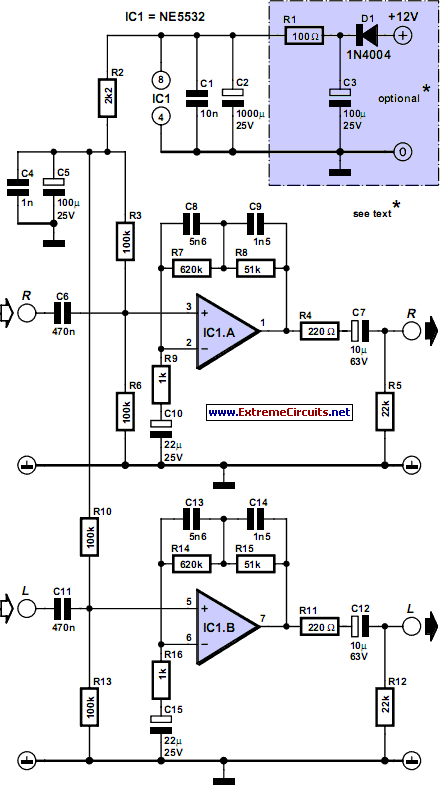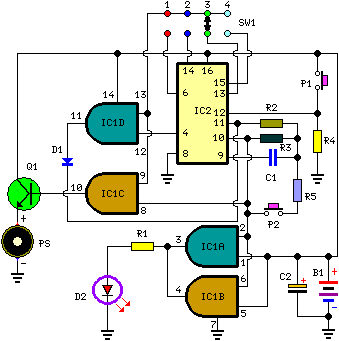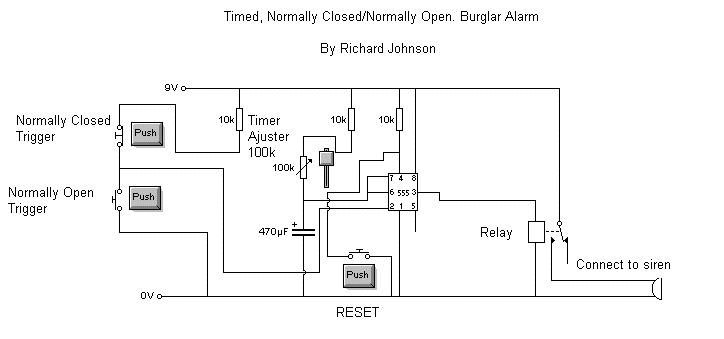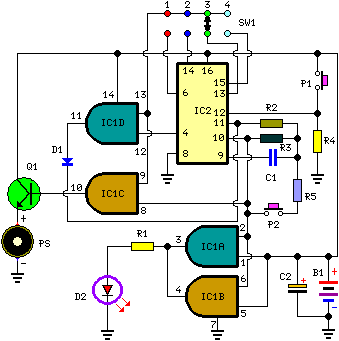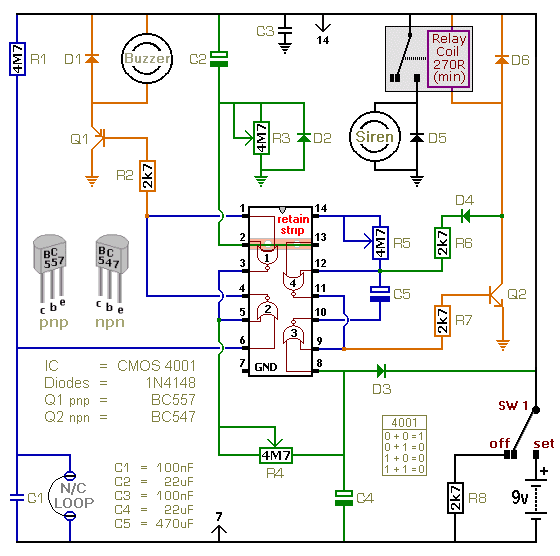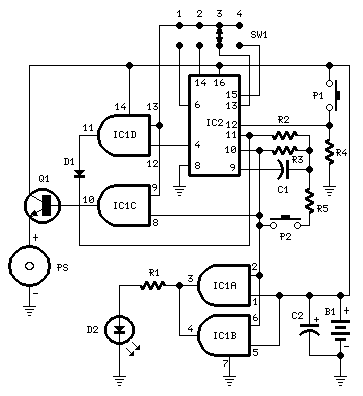
Timed Beepers

This circuit is designed for alerting purposes after a specific duration has elapsed. It is suitable for table games that require a fixed time to answer a question or move a piece, serving as a modern substitute for an hourglass. It is also useful for timing activities such as children's tooth brushing (at least two minutes) or kitchen tasks. Pressing P1 resets IC2, which begins oscillating at a frequency determined by R3 and C1. With the specified values, this frequency is approximately 4 Hz. The LED D2, driven by IC1A and IC1B, flashes at the same oscillator frequency, indicating proper circuit operation. SW1 selects the appropriate pin of IC2, thus adjusting the timing duration. When the selected pin of IC2 goes high, IC1C activates Q1, causing the piezo sounder to beep intermittently at the same frequency as the LED. After approximately 7.5 seconds, pin 4 of IC2 goes high, and IC1D stops the oscillator through D1. To stop the counting prematurely, P2 can be pressed. SW1 can be any type of switch with the desired number of positions. For a single fixed timing duration, the switch can be omitted, and pins 9 and 13 of IC1 can be connected to the appropriate pin of IC2. The circuit's reset is not immediate; pressing P2 forces IC2 to oscillate rapidly, but it may take several seconds to terminate the counting, especially if a longer timer duration is selected and the button is pressed shortly after the circuit starts. To expedite the reset process, reducing the value of R5 may be beneficial, but caution is advised, as a value that is too low could halt oscillation.
This alerting circuit utilizes an integrated circuit (IC) timer, specifically IC2, which can be a 555 timer or a similar device configured in astable mode. The timing components R3 and C1 dictate the oscillation frequency, which is critical for determining how long the alert will sound. The output from IC2 is fed into a series of logic gates (IC1A, IC1B, IC1C, and IC1D) to manage the LED and piezo sounder. The flashing LED serves as a visual cue that the circuit is operational, while the piezo sounder provides an auditory alert.
SW1 acts as a selector switch, allowing the user to choose different timing intervals by connecting specific pins of IC2 to the circuit. This flexibility is essential for various applications, such as games or timed tasks. The design also incorporates a reset mechanism via P1, which initializes the timer, and P2, which allows for an early termination of the alert.
The circuit's performance can be influenced by the resistor values used, particularly R5, which affects the timing reset speed. Adjusting this resistor must be done carefully to maintain the circuit's functionality without compromising the oscillator's operation. Overall, the circuit provides a practical solution for timing applications, combining visual and auditory signals to enhance user experience.This circuit is intended for alerting purposes after a certain time is elapsed. It is suitable for table games requiring a fixed time to answer a question, or to move a piece etc. In this view it`s a modern substitute for the old sandglass. Useful also for time control when children are brushing teeth (at least two minutes!), or in the kitchen, an d so on. Pushing P1 resets IC2 that start oscillating at a frequency fixed by R3 & C1. With values shown, this frequency is approx. 4Hz. The LED D2, driven by IC1A & B, flashing at the same oscillator frequency, signals proper circuit operation. SW1 selects the appropriate pin of IC2 thus adjusting timing duration: When the selected pin of IC2 goes high, IC1C drives Q1 and the piezo sounder beeps intermittently at the same frequency of the LED.
After approx. 7. 5 seconds pin 4 of IC2 goes high and IC1D stops the oscillator through D1. If you want to stop counting in advance, push P2. SW1 can be any type of switch with the desired number of ways. If you want a single fixed timing duration, omit the switch and connect pins 9 & 13 of IC1 to the suitable pin of IC2. The circuit`s reset is not immediate. Pushing P2 forces IC2 to oscillate very fast, but it takes some seconds to terminate the counting, especially if higher timer`s duration is chosen and the pushbutton is operated when the circuit has just started.
In order to speed the reset, try lowering the value of R5, but pay attention: too low a value can stop oscillation. 🔗 External reference
This alerting circuit utilizes an integrated circuit (IC) timer, specifically IC2, which can be a 555 timer or a similar device configured in astable mode. The timing components R3 and C1 dictate the oscillation frequency, which is critical for determining how long the alert will sound. The output from IC2 is fed into a series of logic gates (IC1A, IC1B, IC1C, and IC1D) to manage the LED and piezo sounder. The flashing LED serves as a visual cue that the circuit is operational, while the piezo sounder provides an auditory alert.
SW1 acts as a selector switch, allowing the user to choose different timing intervals by connecting specific pins of IC2 to the circuit. This flexibility is essential for various applications, such as games or timed tasks. The design also incorporates a reset mechanism via P1, which initializes the timer, and P2, which allows for an early termination of the alert.
The circuit's performance can be influenced by the resistor values used, particularly R5, which affects the timing reset speed. Adjusting this resistor must be done carefully to maintain the circuit's functionality without compromising the oscillator's operation. Overall, the circuit provides a practical solution for timing applications, combining visual and auditory signals to enhance user experience.This circuit is intended for alerting purposes after a certain time is elapsed. It is suitable for table games requiring a fixed time to answer a question, or to move a piece etc. In this view it`s a modern substitute for the old sandglass. Useful also for time control when children are brushing teeth (at least two minutes!), or in the kitchen, an d so on. Pushing P1 resets IC2 that start oscillating at a frequency fixed by R3 & C1. With values shown, this frequency is approx. 4Hz. The LED D2, driven by IC1A & B, flashing at the same oscillator frequency, signals proper circuit operation. SW1 selects the appropriate pin of IC2 thus adjusting timing duration: When the selected pin of IC2 goes high, IC1C drives Q1 and the piezo sounder beeps intermittently at the same frequency of the LED.
After approx. 7. 5 seconds pin 4 of IC2 goes high and IC1D stops the oscillator through D1. If you want to stop counting in advance, push P2. SW1 can be any type of switch with the desired number of ways. If you want a single fixed timing duration, omit the switch and connect pins 9 & 13 of IC1 to the suitable pin of IC2. The circuit`s reset is not immediate. Pushing P2 forces IC2 to oscillate very fast, but it takes some seconds to terminate the counting, especially if higher timer`s duration is chosen and the pushbutton is operated when the circuit has just started.
In order to speed the reset, try lowering the value of R5, but pay attention: too low a value can stop oscillation. 🔗 External reference
